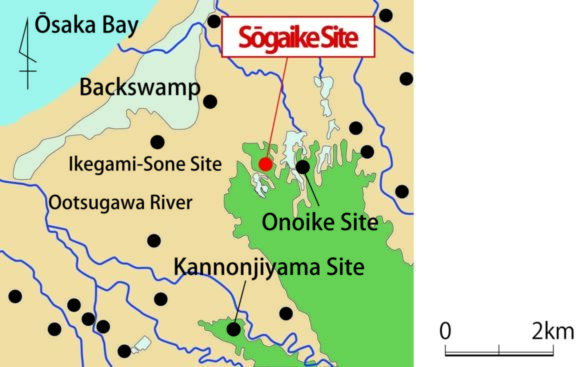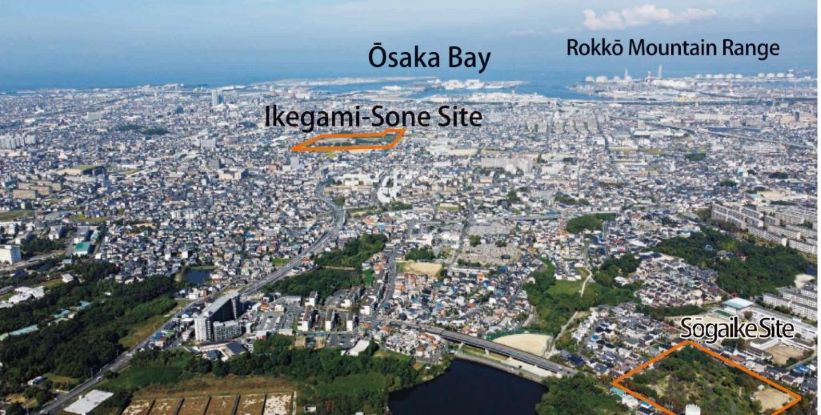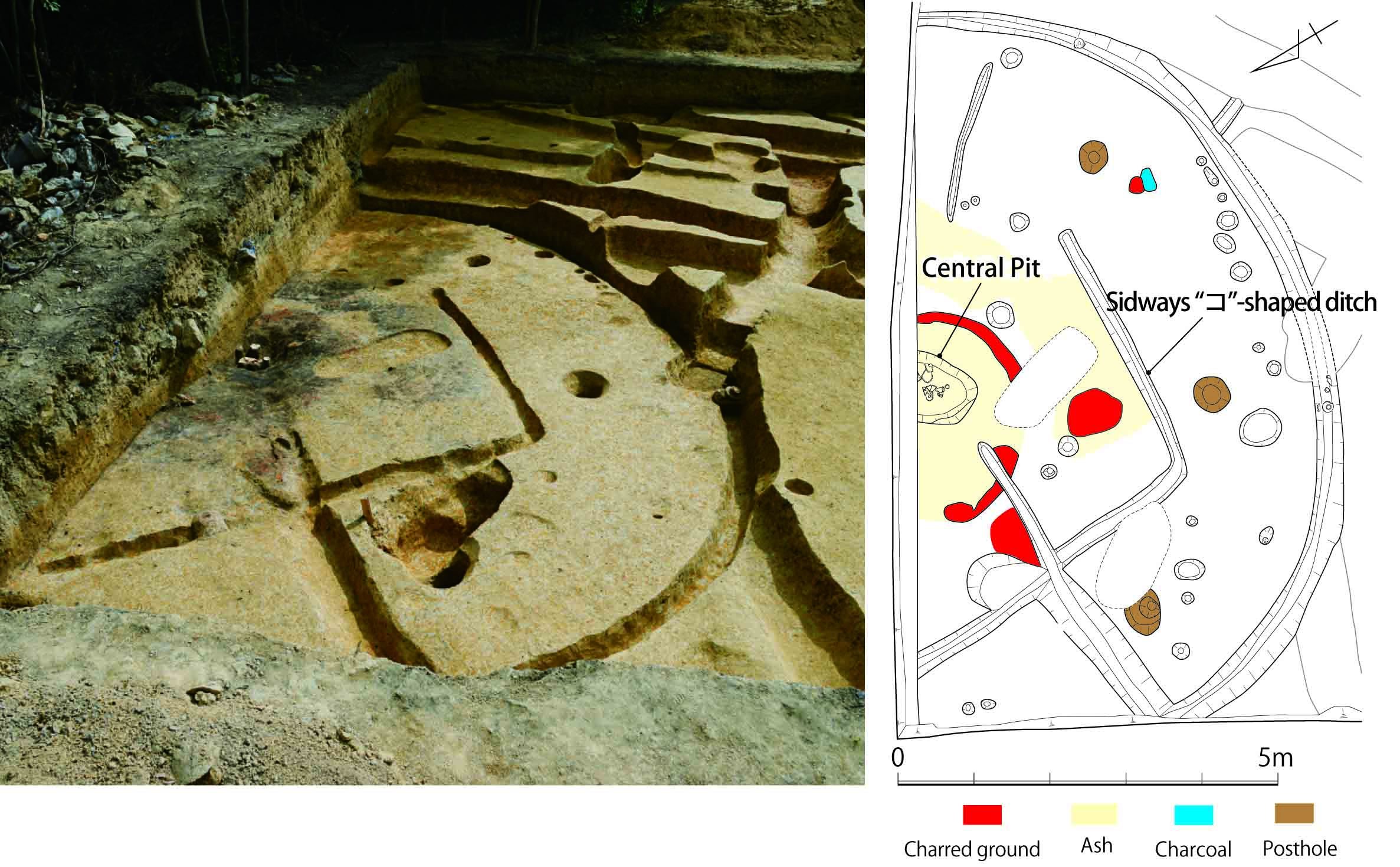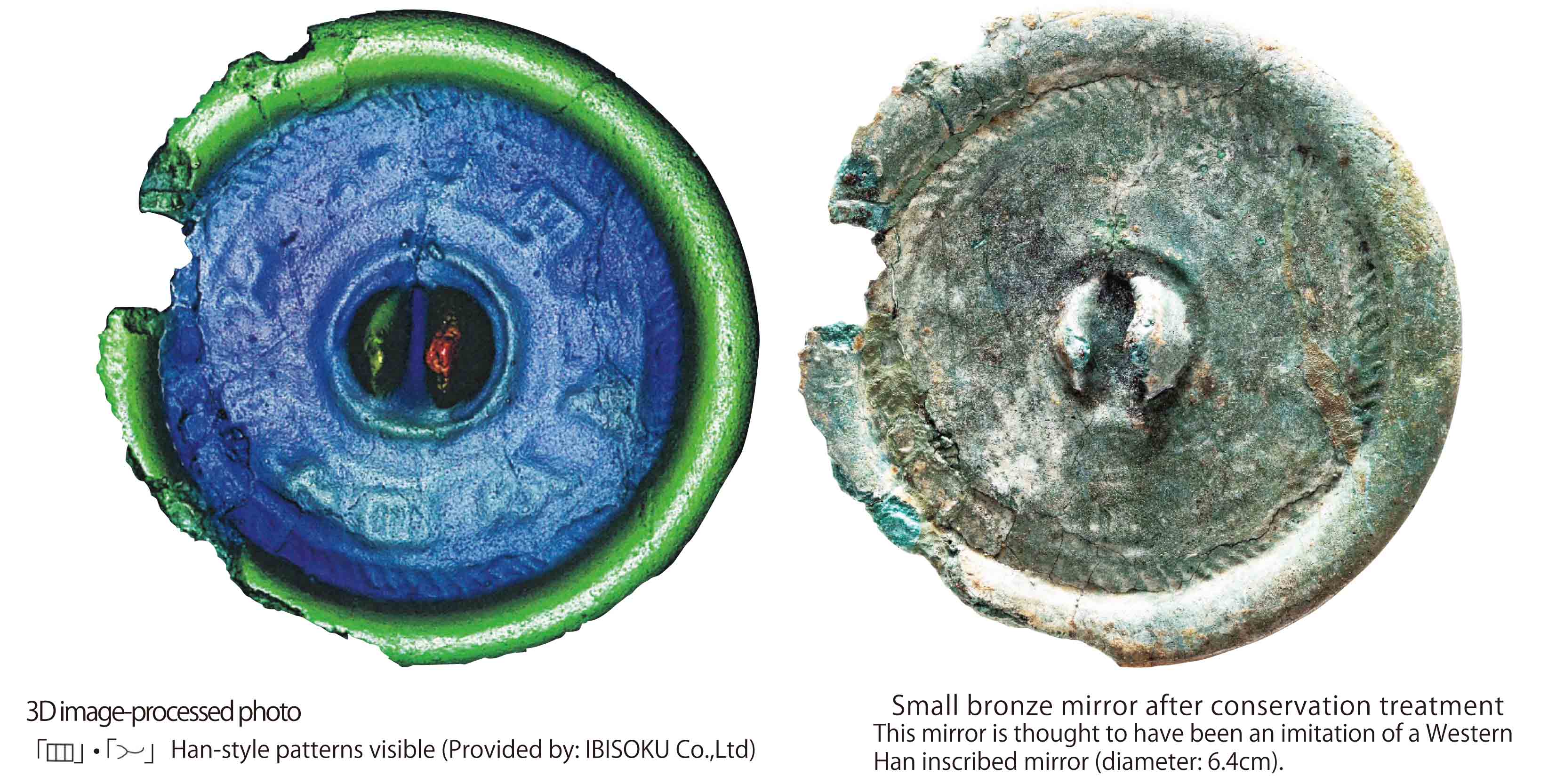Izumi, Ōsaka Prefecture
Middle-Late Yayoi Period (ca. 1900 years ago)
 The Sōgaike site and surrounding settlements of the same period (marked with ●)
The Sōgaike site and surrounding settlements of the same period (marked with ●)
The Kannonjiyama and Onoike sites, which are also highland settlements, are also located in the highland region. The highland region (green) is approximately 50m above sea level. The provided map is an estimated reconstruction of the topography of the Yayoi period.

A distant view of the ruins (from the southeast)
Across Ōsaka Bay, the Rokkō mountain range to the north and Awajishima Island to the west can be seen. 2 kilometers to the northwest is the Ikegami Sone Ruins, a historic hub settlement during the Yayoi Period.

Pit building with iron forge (from the northwest) and survey map
Charcoal, ash, and charred ground spread around the central pit of the pit building, and sideways “コ”-shaped ditch.

Discovery of small bronze mirrors and a Blacksmith’s forge in a highland settlement
The Sōgaike Site is a highland settlement located approximately 50-60 meters above sea level in the Shinoda yama Hills, which run north-south through the northern part of Izumi City, Ōsaka Prefecture. Highland settlements are settlements that were built on mountain tops and hill ridges approximately 2,000 years ago. After the sites discovery in 1960, excavations were conducted in 1965 and 1969. In 2011, pit buildings, ditches, and pillar holes were uncovered. It was hypothesized that ironworking may have been carried out in the village, but this was not confirmed at the time.
During the excavation in 2021, a pit building with a blacksmithing forge in addition to the remains of a pit building, ditch, and pillar holes dating from the middle of the Late Yayoi Period (approximately 1,900 years ago) were uncovered. The scale of the village was revealed to be 420m long and 60-80m wide, while also showcasing the first clear evidence of ironworking in the village. Excavated artifacts include Yayoi earthenware, as well as stone knives and stone arrowheads, but the most notable artifact is a small bronze mirror, one of the oldest in the Kinki region. The discovery of the forge and the small bronze mirror are essential finds when considering the metalware culture of the late Yayoi period in the Kinki region.
The pit building with the forge is a large building with a diameter of 9.8 meters and is thought to have been supported by six pillars. There is a pit in the center with a radius of 1.25 meters, which charcoal and charred ground are concentrated, with further charcoal and charred ground distributed around the outside of the pit as well. The central pit and the area of concentration of charcoal and charred ground were surrounded by a sideways “コ”-shaped ditch. Based on the characteristics of these remains and the fact that small quantities of whetstone, stone, and beaten stone were excavated from inside the pit building, it is thought that the area around the central pit was a blacksmithing forge for making ironware. The sideways “コ”-shaped ditch surrounding the forge is unique, with no extant examples to draw from.
The small bronze mirror was made in Japan, in imitation of mirrors made by the Han Dynasty in mainland China at that time; and were excavated from a pit at the southeastern end of the research area. The design on the back of the mirror was unclear due to deterioration and other factors. However, 3D image-processing enabled the confirmation of certain patterns that faithfully imitate Chinese mirrors from the period. In addition, the narrower edge and hemispherical shape of the central knob also suggest that this is one of the oldest small bronze mirrors in the Kinki region.
The above-mentioned excavations shed a light on the Sōgaike Site as being one of the largest settlements in the Izumi area. Furthermore, and it was revealed that the site contained bronze and iron artifacts, such as one of the oldest small bronze mirrors in the Kinki region, which were extremely valuable items at the time. Highland settlements were once thought to be isolated places, such as defensive castles or settlements. However, in recent years, studies seek to examine these sites from various perspectives, including the duration of their existence and excavated artifacts. In this context, the existence of the Sōgaike Site, an advanced settlement that accepted cutting-edge goods and technology at an early stage, has important implications for future research on highland settlements as well as Late Yayoi society in the Izumi region and the Japanese archipelago as a whole. (Yūto Ueda)
Adapted from Hakkutsu sareta Nihon rettō 2023 [Excavations in the Japanese Archipelago, 2023] (Bunkachō [Agency for Cultural Affairs], ed., Kyodo News, 2023).

